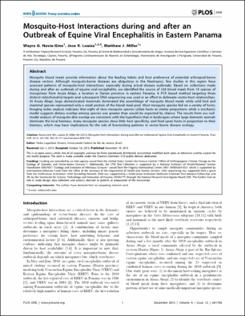| dc.contributor.author | Navia-Gine, Wayra G. | |
| dc.contributor.author | Loaiza, Jose R. | |
| dc.contributor.author | Miller, Matthew J. | |
| dc.date.accessioned | 2020-07-09T06:11:07Z | |
| dc.date.available | 2020-07-09T06:11:07Z | |
| dc.date.issued | 2013-12-10 | |
| dc.identifier.other | https://doi.org/10.1371/journal.pone.0081788 | |
| dc.identifier.uri | http://repositorio-indicasat.org.pa/handle/123456789/193 | |
| dc.description | Mosquito blood meals provide information about the feeding habits and host preference of potential arthropod-borne disease vectors. Although mosquito-borne diseases are ubiquitous in the Neotropics, few studies in this region have assessed patterns of mosquito-host interactions, especially during actual disease outbreaks. Based on collections made during and after an outbreak of equine viral encephalitis, we identified the source of 338 blood meals from 10 species of mosquitoes from Aruza Abajo, a location in Darien province in eastern Panama. A PCR based method targeting three distinct mitochondrial targets and subsequent DNA sequencing was used in an effort to delineate vector-host relationships. At Aruza Abajo, large domesticated mammals dominated the assemblage of mosquito blood meals while wild bird and mammal species represented only a small portion of the blood meal pool. Most mosquito species fed on a variety of hosts; foraging index analysis indicates that eight of nine mosquito species utilize hosts at similar proportions while a stochastic model suggests dietary overlap among species was greater than would be expected by chance. The results from our nullmodel analysis of mosquito diet overlap are consistent with the hypothesis that in landscapes where large domestic animals dominate the local biomass, many mosquito species show little host specificity, and feed upon hosts in proportion to their biomass, which may have implications for the role of livestocking patterns in vector-borne disease ecology. | en_US |
| dc.description.abstract | Mosquito blood meals provide information about the feeding habits and host preference of potential arthropod-borne disease vectors. Although mosquito-borne diseases are ubiquitous in the Neotropics, few studies in this region have assessed patterns of mosquito-host interactions, especially during actual disease outbreaks. Based on collections made during and after an outbreak of equine viral encephalitis, we identified the source of 338 blood meals from 10 species of mosquitoes from Aruza Abajo, a location in Darien province in eastern Panama. A PCR based method targeting three distinct mitochondrial targets and subsequent DNA sequencing was used in an effort to delineate vector-host relationships. At Aruza Abajo, large domesticated mammals dominated the assemblage of mosquito blood meals while wild bird and mammal species represented only a small portion of the blood meal pool. Most mosquito species fed on a variety of hosts; foraging index analysis indicates that eight of nine mosquito species utilize hosts at similar proportions while a stochastic model suggests dietary overlap among species was greater than would be expected by chance. The results from our nullmodel analysis of mosquito diet overlap are consistent with the hypothesis that in landscapes where large domestic animals dominate the local biomass, many mosquito species show little host specificity, and feed upon hosts in proportion to their biomass, which may have implications for the role of livestocking patterns in vector-borne disease ecology. | en_US |
| dc.language.iso | eng | en_US |
| dc.rights | info:eu-repo/semantics/openAccess | |
| dc.rights | https://creativecommons.org/publicdomain/zero/1.0/ | |
| dc.subject | Mosquito-Host Interactions | en_US |
| dc.subject | Outbreak of Equine | en_US |
| dc.subject | Viral Encephalitis | en_US |
| dc.subject | Panama | en_US |
| dc.title | Mosquito-Host Interactions during and after an Outbreak of Equine Viral Encephalitis in Eastern Panama | en_US |
| dc.type | info:eu-repo/semantics/article | en_US |
| dc.type | info:eu-repo/semantics/publishedVersion | |

